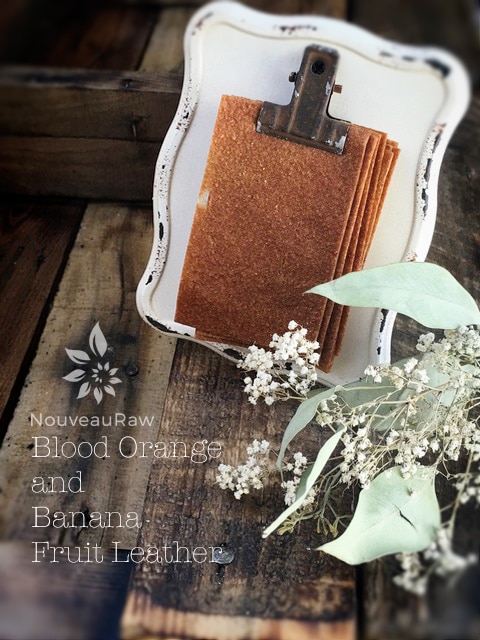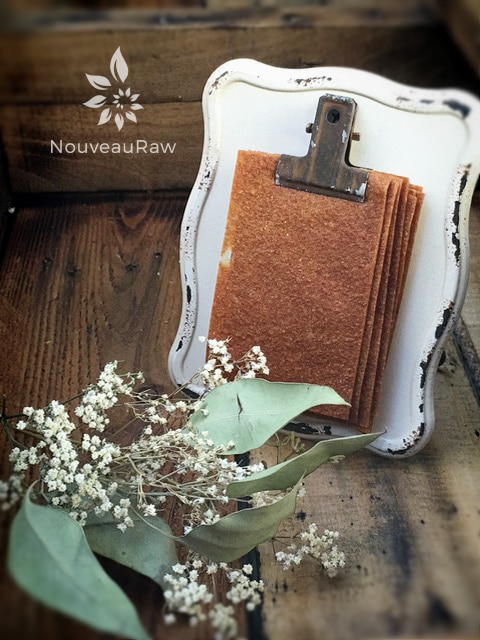Blood Orange and Banana Fruit Leather

 Add to favorites
Add to favorites

~ raw, vegan, gluten-free, nut-free ~
This fruit leather turned out to be a fun one. I am a fan of the banana, and I am not afraid to send it on a blind date with an unknown partner. This leather came out soft and chewy.
At first, you taste the banana when you bit into it, then afterward the citrus lingers in the background. It makes you question what it is exactly what you are tasting. We grow up eating certain foods, and as adults, we tend to stick to what we are comfortable with. I am here today, asking you to step out of your comfort zone and give this recipe a try.
Ingredients:
yields 2 cups puree
- 2 bananas, ripe
- 1 blood orange, peeled
- 1 Tbsp maple syrup
Preparation:
- Select RIPE or overly ripe bananas and orange that have reached a peak in color, texture, and flavor.
- Puree the fruit and maple syrup, in the blender or food processor until smooth. Taste and sweeten more if needed. Keep in mind that flavors will intensify as they dehydrate. When adding a sweetener do so a little at a time, and reblend, tasting until it is at the desired taste. It is best to use a liquid type sweetener. Don’t use a granulated sugar because it tends to change the texture.
- Spread the fruit puree on teflex sheets that come with your dehydrator. Pour the puree to create an even depth of 1/8 to 1/4 inch. If you don’t have teflex sheets for the trays, you can line your trays with plastic wrap or parchment paper. Do not use wax paper or aluminum foil.
- Lightly coat the food dehydrator plastic sheets or wrap with a cooking spray, I use coconut oil that comes in a spray.
- When spreading the puree on the liner, allow about an inch of space between the mixture and the outside edge. The fruit leather mixture will spread out as it dries, so it needs a little room to allow for this expansion.
- Be sure to spread the puree evenly on your drying tray. When spreading the puree mixture, try tilting and shaking the tray to help it distribute more evenly. Also, it is a good idea to rotate your trays throughout the drying period. This will help assure that the leathers dry evenly.
 Dehydrate the fruit leather at 145 degrees (F) for 1 hour, reduce temp to 115 degrees (F) and continue drying for about 16 (+/-) hours. The finished consistency should be pliable and easy to roll.
Dehydrate the fruit leather at 145 degrees (F) for 1 hour, reduce temp to 115 degrees (F) and continue drying for about 16 (+/-) hours. The finished consistency should be pliable and easy to roll.
- Check for dark spots on top of the fruit leather. If dark spots can be seen it is a sign that the fruit leather is not completely dry.
- Press down on the fruit leather with a finger. If no indentation is visible or if it is no longer tacky to the touch, the fruit leather is dry and can be removed from the dehydrator.
- Peel the leather from the dehydrator trays or parchment paper. If it peels away easily and holds its shape after peeling, it is dry. If it is still sticking or loses its shape after peeling, it needs further drying.
- Under-dried fruit leather will not keep; it will mold. Over-dried fruit leather will become hard and crack, although it will still be edible and will keep for a long time
- Storage: to store the finished fruit leather…
- Allow the leather to cool before wrapping up to avoid moisture from forming, thus giving it a breeding ground for molds.
- Roll them up and wrap them tightly with plastic wrap. Click (here) to see photos of how I wrap them.
- Place in an air-tight container, and store in a dry, dark place. (Light will cause the fruit leather to discolor.)
- The fruit leather will keep at room temperature for one month, or in a freezer for up to one year.
Culinary Explanations:
- Why do I start the dehydrator at 145 degrees (F)? Click (here) to learn the reason behind this.
- When working with fresh ingredients, it is important to taste test as you build a recipe. Learn why (here).
- Don’t own a dehydrator? Learn how to use your oven (here). I do however truly believe that it is a worthwhile investment. Click (here) to learn what I use.
© AmieSue.com
Tags: Dairy Free, Gluten Free, Nut Free, Refined Sugar Free, Soy Free, sugar free, Vegan



 Add to favorites
Add to favorites
 Dehydrate the fruit leather at 145 degrees (F) for 1 hour, reduce temp to 115 degrees (F) and continue drying for about 16 (+/-) hours. The finished consistency should be pliable and easy to roll.
Dehydrate the fruit leather at 145 degrees (F) for 1 hour, reduce temp to 115 degrees (F) and continue drying for about 16 (+/-) hours. The finished consistency should be pliable and easy to roll.
I am completely intrigued with your recipes and would love to try the dried fruits- But in the past when I have dehydrated some fruits, apples, bananas, they never held the color and yours are so fresh looking! What is the secret? Is it the temperature control that holds the color?
Hello Christy,
Some fruits hold color better than others and it will also depend on the quality of fruit that you start out with. Sometimes strawberries can be so vibrant in color and other times, not so much. You can also add a splash of lemon juice but be careful not to add too much to overpower the recipe. I find that red fruits make for the most vibrant fruit leathers and I never add lemon juice (usually, shouldn’t ever say never). I do wish they would remain the color that you see after blending and pouring them on the dehydrator sheet… ooooh so pretty.
I hope you try some of the recipes. Please keep me posted if you do. Sending you bright-fruit-leather-blessings, hehe amie sue